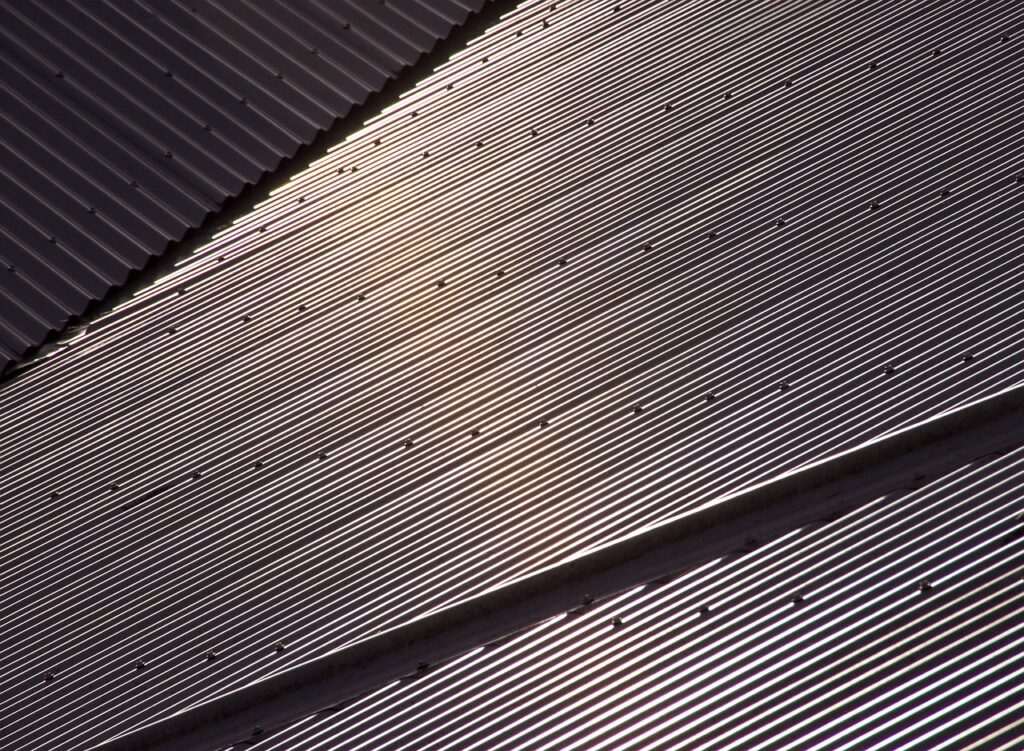There is wood and clay, and then there is metal.
Metal roofs have become increasingly popular among commercial and residential property owners. This is due to their durability, longevity, and modern appearance.
The preference for metal over traditional materials like asphalt shingles or clay tiles has grown steadily, driven by both practical benefits and evolving architectural trends. For those considering metal building construction or roof replacement, understanding what metal roofing offers is essential.
Types of Metal Roofs Commonly Used
Several types of metal roofs are used in buildings today, each with its specific characteristics. Standing seam metal roofs are one of the most recognized for their sleek lines and hidden fasteners. Corrugated metal roofing is often used in agricultural or industrial applications and features a wavy pattern for added strength. Metal shingles can mimic the look of more traditional roofing materials while providing the benefits of metal. Each type has unique installation methods, maintenance requirements, and cost implications.
Durability and Longevity of Metal Roofs
One of the most significant advantages of metal roofs is their long lifespan. Many metal roofing systems last forty to seventy years depending on the material and environmental conditions. Unlike other materials that deteriorate over time, metal resists many common forms of roof damage. It holds up well against wind, rain, snow, and even fire. This makes metal roofing an ideal option for areas experiencing extreme weather patterns or fluctuating temperatures.
Energy Efficiency and Insulation Properties
Metal roofs contribute to energy efficiency through their reflective properties. Light-colored or specially coated metal roofs reflect solar radiant heat instead of absorbing it, which helps reduce cooling costs during warm months. In combination with proper insulation, a metal roof can significantly stabilize indoor temperatures, reducing the burden on HVAC systems. The energy savings associated with these roofs often balance out the initial installation cost over time.
Environmental Considerations
Metal roofing is often made from recycled materials and is itself fully recyclable at the end of its life cycle. This aspect appeals to environmentally conscious property owners looking to reduce their carbon footprint. Unlike asphalt shingles, which often end up in landfills, metal roofing can be reused and repurposed. Additionally, the light weight of metal reduces the structural demands on buildings, leading to lower material usage during construction.
Cost Implications of Installation and Maintenance
The upfront cost of installing a metal roof tends to be higher than more traditional options, but the long-term savings are considerable. Fewer repairs, less frequent replacements, and lower energy bills contribute to the total return on investment. Maintenance requirements are minimal compared to other materials. Regular inspections, occasional cleaning, and prompt attention to any surface damage are typically sufficient to maintain peak performance.
Performance in Severe Weather Conditions
Metal roofs perform exceptionally well in a variety of harsh climates. High wind resistance makes them suitable for hurricane-prone regions, while their ability to shed snow quickly benefits colder areas. In addition, most metal roofs have excellent fire resistance ratings, which is a critical consideration in areas susceptible to wildfires. These properties make metal roofs a reliable choice for ensuring long-term protection.
Addressing Common Misconceptions
There are several myths surrounding metal roofs. One common belief is that they are noisier during rainstorms. In reality, proper insulation and underlayment significantly dampen sound. Another misconception is that metal roofs attract lightning. Scientific evidence shows that metal roofing does not increase the risk of lightning strikes, and in fact, it can safely disperse energy if struck. Concerns about rust are also largely unfounded when quality coatings and materials are used.
Aesthetic Versatility and Customization Options
Today’s metal roofs are available in a wide range of colors, textures, and finishes. This allows property owners to achieve various looks that complement the rest of the building’s design. Metal can be shaped and painted to resemble tile, slate, or wood, making it an adaptable option for both traditional and contemporary styles. These aesthetic possibilities have contributed to the rising popularity of metal roofs in residential settings.
Installation Process and Time Requirements
Installing a metal roof typically requires specialized skills and tools, which is why professional installation is recommended. The process involves laying down underlayment, securing panels or shingles, and sealing edges to prevent leaks. Installation time can vary depending on the roof size and complexity, but it is generally faster than other systems due to the larger size of metal panels. Proper installation ensures maximum durability and efficiency.
Comparison with Other Roofing Materials
Compared to asphalt shingles, metal roofs last significantly longer and require less maintenance. They outperform wood shakes in terms of fire resistance and moisture control. Clay tiles are more fragile and prone to breakage, while metal maintains its integrity under physical stress. Though the initial investment is greater, the superior performance and longevity make metal a more cost-effective option over the lifespan of the building.
Importance of Proper Ventilation
Ventilation plays a critical role in the performance of metal roofs. Without adequate airflow, moisture can accumulate beneath the roof deck, leading to mold and structural damage. Properly designed ventilation systems help control indoor temperature and extend the life of the roofing materials. Ridge vents, soffit vents, and other airflow solutions must be integrated into the design to ensure long-term effectiveness.
Noise Control and Interior Comfort
Concerns about noise are understandable but largely exaggerated. Modern installation techniques include noise-dampening insulation and solid sheathing, which significantly reduce sound transmission. In fact, many metal roofs are quieter than their traditional counterparts once these features are in place. Homeowners who have made the switch often report improved comfort and a noticeable decrease in outside noise levels.
Impact on Property Value
A well-installed metal roof can increase a property’s resale value. Potential buyers often view metal as a premium feature due to its durability and low maintenance requirements. The energy efficiency benefits also appeal to eco-conscious buyers. Additionally, having a relatively new roof with decades of expected performance remaining can make a property more attractive in a competitive market.
Insurance and Warranty Considerations
Many insurance companies offer discounts on premiums for homes with metal roofs due to their proven resilience. When selecting a metal roof, reviewing the warranty is essential. Manufacturers often provide warranties that range from twenty to fifty years, covering defects in materials and coating. Installation warranties may also be available through contractors. Understanding these protections helps homeowners make informed decisions.
Corrosion Resistance and Protective Coatings
Metal roofs are treated with coatings that resist corrosion, UV degradation, and physical damage. Galvanized steel, aluminum, and zinc are commonly used materials known for their resistance to rust. Protective coatings such as Kynar or polyester paint systems add an additional layer of defense and enhance aesthetic appeal. Regular inspections ensure these coatings remain intact, further extending the life of the roof.
Sustainability and Long-Term Planning
Sustainability is a major factor for modern construction projects, and metal roofs align well with green building principles. Their long lifespan reduces the need for frequent replacement, lowering resource consumption. Recyclability and energy efficiency add to their environmental benefits. For those looking to invest in sustainable architecture, metal roofs offer a forward-thinking solution that balances function and responsibility.
Suitability for Various Building Types
Metal roofs are not limited to industrial or commercial use. Residential homes, agricultural buildings, recreational structures, and even architectural landmarks have all adopted metal roofing. The flexibility of design, combined with superior performance, makes metal roofing suitable for virtually any application. Whether in urban environments or rural settings, metal roofs meet a wide range of functional and aesthetic needs.
Future Trends in Metal Roofing
Advancements in technology continue to influence metal roofing systems. Innovations in paint coatings, solar integration, and insulation techniques are expanding the capabilities of these roofs. Smart roofing systems equipped with sensors can monitor structural integrity and weather conditions. As sustainability becomes a greater priority, the role of metal in future-proof construction will likely grow.
Conclusion
Understanding the truth about metal building roofs involves looking beyond surface impressions and marketing claims. These roofing systems offer unmatched durability, environmental benefits, and aesthetic flexibility. While the upfront cost may be higher, the long-term value and performance justify the investment. As construction practices evolve, metal roofs remain a practical and forward-thinking choice for anyone planning to build or renovate.

